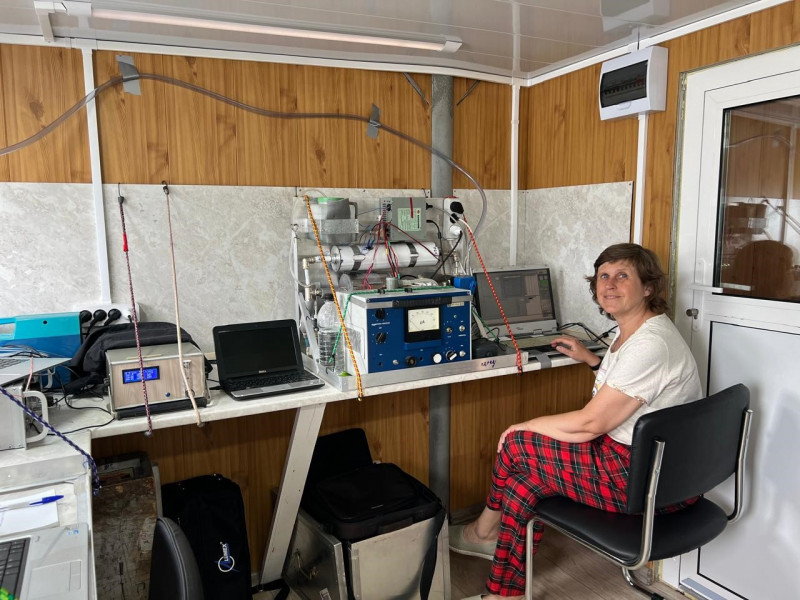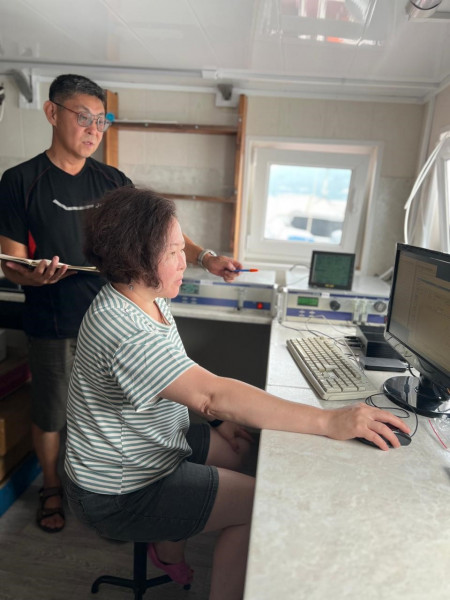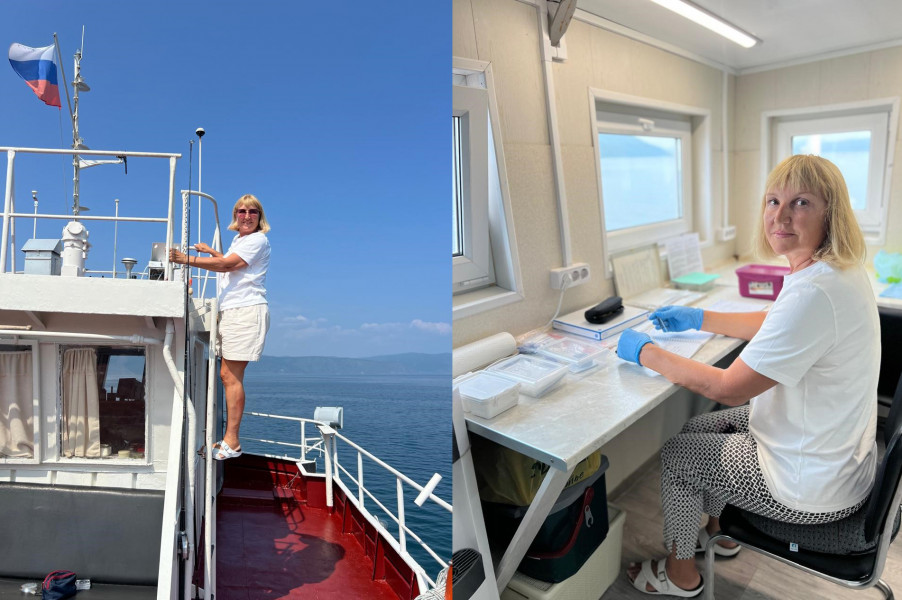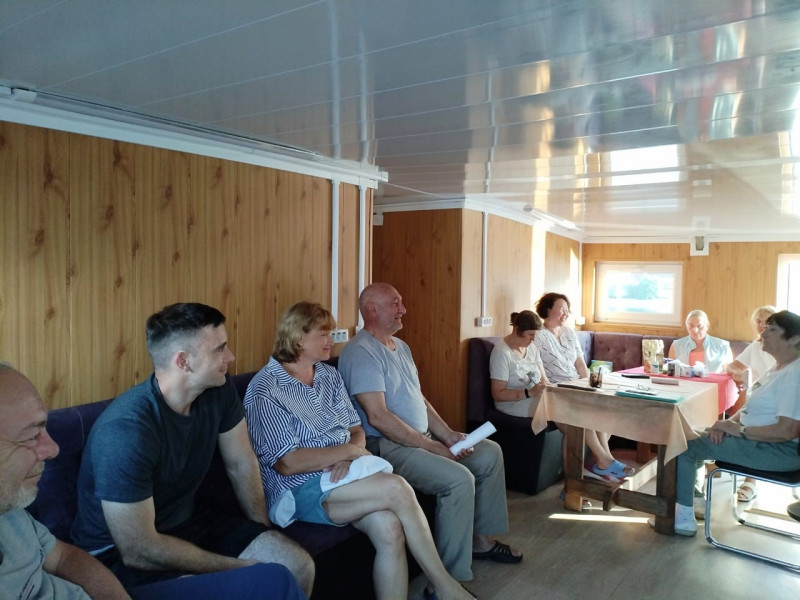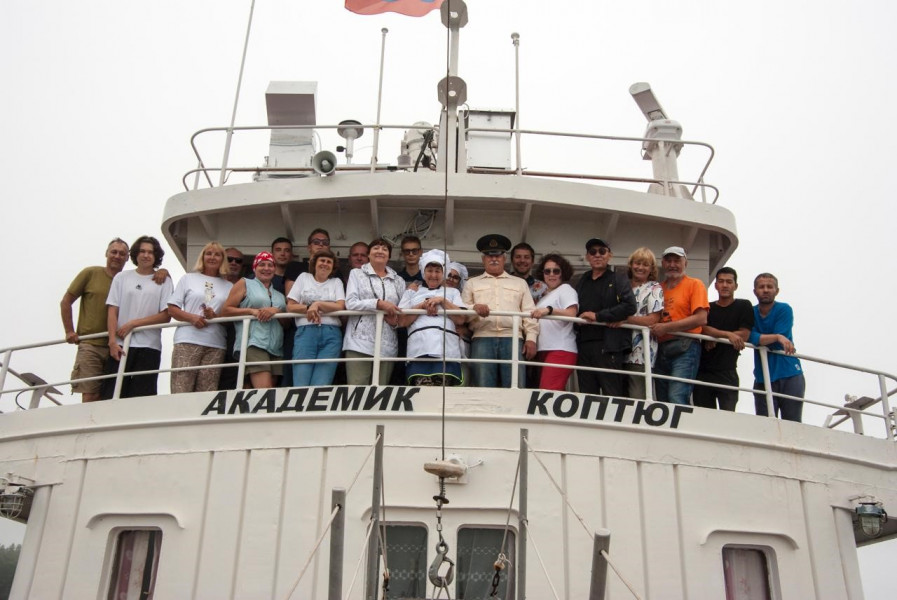Expedition onboard the R/V “Akademik Koptyug” on July 17-29, 2024
On July 17-29, 2024, a complex expedition onboard the R/V “Akademik Koptyug” was carried out within the RSF project “Studies of the Composition and Spatio-Temporal Distribution of Aerosol-Gas Impurities of the Atmosphere in the Water Area of Lake Baikal” (19-77-20058-P) (led by Khodzher T.V.) and within the State assignment of the Institute “Study of the role of atmospheric deposition on aquatic and terrestrial ecosystems of the Lake Baikal basin, identification of sources of atmospheric pollution” (0279-2021-0014) (led by Khodzher T.V.).
The purpose of the expedition is to conduct comprehensive continuous observations of physical parameters and chemical composition of aerosol, gas impurities, meteorological conditions in the atmosphere above the water area of Lake Baikal using the equipment of LIN SB RAS, IPMS SB RAS and instrument base of CUC “Atmosphere” IAO SB RAS; to assess the contribution of anthropogenic sources of Pribaikalie, hazardous natural phenomena (forest fires), ship exhaust gases to the atmospheric pollution over the lake in summer.
The expedition route covered the entire perimeter of Lake Baikal with stops in the area of large local sources of atmospheric pollution on the lake coast, estuaries of large tributaries and bays.
To obtain information on the vertical distribution and temporal dynamics of aerosol over the lake water area, the possibilities of the mobile aerosol-Raman lidar “LOZA-A2” were used.

The main attention was paid to studying the peculiarities of temporal changes in the vertical structure of aerosol fields in the conditions of the mountain basin, as well as identifying the conditions of their formation and determining the main sources of aerosol. As an example, an image of the lower troposphere on 27 July 2024, Figure 2 shows a fragment of the window of the lidar data visualization program. This episode of observations is of interest because during measurements, watered aerosol particles at a height of 4÷5.5 km begin to fall out of the cloud into the underlying layers, but at a height of 3.5 km they are “locked” by the inversion layer, which does not allow the aerosol to fall below.

Condensation activity and fugacity parameters of submicron aerosol and different size fractions from 0.3 to 10 μm in the near-water atmosphere were estimated using a FAN turbidimeter and photoelectric particle counters. The maximum number concentrations of particles larger than 0.3 µm were observed in the atmosphere of the Angara River source (158 cm-3) and at the station in the port of Turka (170 cm-3), and the minimum concentrations were recorded in Ayaya Bay (8 cm-3). Increased concentrations were also recorded near large settlements: Baikalsk (100 cm-3), Listvyanka (80-90 cm-3), Khuzhir (80-100 cm-3). The condensation activity parameter calculated for integral particle concentrations larger than 0.3 μm varied between 0.15 and 0.2. The parameter F, which estimates the volume fraction of the fast evaporating substance in the aerosol particles, varied between 0.2-0.1, the slow evaporating substance Q (conventionally “sulphates”) was 0.4-0.6. The share of “noncombustible” substance S was about 0.4. The soot (black carbon) concentration was measured every 15 minutes. Its highest concentrations (up to 8 µg/m3) were observed in the area of Baikalsk town, background ~ 20-50 ng/m3 were recorded in the area of Khakusy and Ayaya Bay in North Baikal. At other sites, as for aerosol particles, the highest values were recorded at the Angara River source (1.5-4 µg/m3), Listvyanka (1.5-3 µg/m3) and Khuzhir (0.4-0.7 µg/m3). In addition, when the ship passed close to motorboats and launches in Listvenichniy Bay, Khuzhir and Turka settlements, splashes of soot up to 0.7-0.8 µg/m3 and even up to 3 µg/m3 were noted.
Concentrations of small gas impurities (SO2, NOx, O3) were measured using chemiluminescent gas analyzers of the “OPTEK” company, meteorological parameters were determined using the “Misol” meteorological complex. As for other parameters, the highest average concentrations of nitrogen oxide and dioxide were observed at the Angara River source - 41 µg/m3 and 38 µg/m3, respectively. Here, the main influence on the increased level of atmospheric pollution was caused by passing launches. The concentration of sulfur dioxide SO2 in the near water layer of the atmosphere varied between 0 and 2 µg/m3.
A high ozone concentration was detected throughout the lake area, with an average value of ~151 µg/m3, probably, as a result of prolonged abnormally hot weather in the Siberian region. Due to the influence of the breeze circulation providing ozone input from the boundary layer of the atmosphere during the night hours, the increased ozone concentrations were noted in some parts of the lake during the stops.
During the expedition, 34 samples of atmospheric aerosol were collected for various chemical analyses to be carried out in the laboratory.
Thus, during the past complex expedition, the spatial-temporal heterogeneity of distribution of many determined parameters in the atmosphere above the water area of Lake Baikal was determined. The variations of these indicators polluting the near-water atmosphere were influenced by meteorological conditions and small cyclones. The main contribution to air pollution came from nearby local sources in the coastal zone and from passing ships. The planned field work was carried out in full, further processing of the results of the complex expedition will be carried out under stationary conditions.




